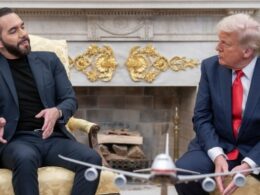Over half a century after the summer of 1973 when he bought his first British retro sports car at the age of 20, Michael Hattem had been ready to buy a new model of the Morgan Plus Four.
However the 73-year-old classic car enthusiast in Los Angeles is now facing a dilemma. The hand-built wood-framed luxury car, which has a price tag of $85,000, may soon become 10 per cent more costly if US President Donald Trump keeps his tariffs on imports of all foreign-made vehicles and automotive parts.
“I just have to save a few pennies more,” Hattem, the president of the Morgan Plus Four Club in Southern California, said jokingly, but added that he was also afraid of buying now in case Trump changed his mind and removed the levies. “Let’s give it another 30 days. We will see what happens with the tariffs.”
Morgan Motor Company, the 116-year-old British specialist carmaker, has unexpectedly been caught in Trump’s tariff crosshairs just as the key model in the marque’s offering returned to the US market for the first time in two decades.
Long before the trade war started, the company’s engineers had been working for years to clear US regulatory hurdles to bring a four-wheeled Morgan to American fans following changes in a local rule that allows companies to replicate models that are more than 25-years-old.
In November, just as Trump won the presidential election, Morgan announced that the Plus Four, which was first introduced in 1950, had finally won approval for sale under the revised US law.
A four-wheeled Morgan car had not been sold in America since 2005 due to US emissions and safety standards, although its three-wheelers, classified as motorbikes, had been available during the model’s absence.
As the vehicles finally arrived in the US in March, Trump announced 25 per cent tariffs on foreign car imports, triggering a flood of inquiries from American consumers worried that their beloved models would suddenly be far more expensive to purchase.
Since 1914, all of Morgan’s cars have been built at a factory outside Malvern in Worcestershire in the west of England. About 90 per cent of vehicle components are made in the UK, while the company sources the Plus Four’s 2 litre engine from German carmaker BMW.
Matthew Hole, managing director at Morgan, said the company planned to pass about half of the tariff costs to consumers, meaning the $84,995 model would cost about 10 per cent more. With taxes and personalisation options, the price would likely go above $125,000.

Orders have already been placed for 200 cars to be sold in the US this year, which would account for about a third of Morgan’s annual revenue of around £48mn. Hole said there has not been “a flight of people cancelling their orders”.
Under US rules, the company cannot sell more than 325 cars a year.
“If you’ve been waiting for a Morgan for the last 20 years . . . a lot of our customers are already emotionally invested in it,” Hole said.
To prepare for the tariffs that came into effect this month, the company had shifted some of the cars that were originally headed to non-US markets for American consumers, and cut back on shipping and logistics costs.

But the options to offset the tariffs are limited for the British company, especially given it can only make 13 cars per week. The average waiting time for a vehicle is up to nine months depending on the model.
Large parts of the cars are still wooden, including the frames that are made with ash timber carved by carpenters using a chisel and hammer. Its aluminium panels are hand beaten by its craftsmen. The same generation of families work at the Morgan factory with skills that are passed on from their grandfathers to their grandchildren.
“One of the reasons why people are buying our car is because it’s built in this historic site in Malvern,” Hole said.
While the tariffs will make its cars more expensive in the US, Steven Armstrong, former European head of Ford who now chairs Morgan, said the US will remain an attractive market for the British group.
“We will continue to grow,” Armstrong said. “The tariffs will take the edge off that growth, but it’s not as if we’re losing something that we had previously.”

Still, Larry Dalphy, one of the 150 members at the Morgan Plus Four Club, said the tariffs would cause the Plus Four to break through “a certain price barrier that some will find hard to swallow”.
Annabelle Tescione, chair of the western New York Morgan owners group, agreed that the bigger price tag from the tariffs would be tough for the average British classic car lover in the US. “Any negative effect on Morgan imports will cause a frown on a lot of our faces, especially after so long a wait for them,” she said.
However, Hattem, who already owns seven Morgan vehicles, expected that he would still buy a new Plus Four if it became clear that tariffs were here to stay.
“I don’t buy expensive jewellery and I don’t buy shoes. But this is my one pleasure,” he said.
Source link









